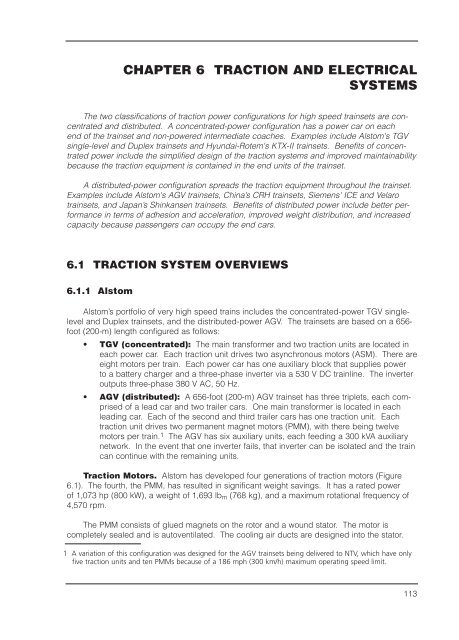Pioneering the Application of High Speed Rail Express Trainsets in ...
Pioneering the Application of High Speed Rail Express Trainsets in ...
Pioneering the Application of High Speed Rail Express Trainsets in ...
You also want an ePaper? Increase the reach of your titles
YUMPU automatically turns print PDFs into web optimized ePapers that Google loves.
CHAPTER 6 TRACTION AND ELECTRICAL<br />
SYSTEMS<br />
The two classifications <strong>of</strong> traction power configurations for high speed tra<strong>in</strong>sets are concentrated<br />
and distributed. A concentrated-power configuration has a power car on each<br />
end <strong>of</strong> <strong>the</strong> tra<strong>in</strong>set and non-powered <strong>in</strong>termediate coaches. Examples <strong>in</strong>clude Alstom's TGV<br />
s<strong>in</strong>gle-level and Duplex tra<strong>in</strong>sets and Hyundai-Rotem's KTX-II tra<strong>in</strong>sets. Benefits <strong>of</strong> concentrated<br />
power <strong>in</strong>clude <strong>the</strong> simplified design <strong>of</strong> <strong>the</strong> traction systems and improved ma<strong>in</strong>ta<strong>in</strong>ability<br />
because <strong>the</strong> traction equipment is conta<strong>in</strong>ed <strong>in</strong> <strong>the</strong> end units <strong>of</strong> <strong>the</strong> tra<strong>in</strong>set.<br />
A distributed-power configuration spreads <strong>the</strong> traction equipment throughout <strong>the</strong> tra<strong>in</strong>set.<br />
Examples <strong>in</strong>clude Alstom's AGV tra<strong>in</strong>sets, Ch<strong>in</strong>a’s CRH tra<strong>in</strong>sets, Siemens' ICE and Velaro<br />
tra<strong>in</strong>sets, and Japan’s Sh<strong>in</strong>kansen tra<strong>in</strong>sets. Benefits <strong>of</strong> distributed power <strong>in</strong>clude better performance<br />
<strong>in</strong> terms <strong>of</strong> adhesion and acceleration, improved weight distribution, and <strong>in</strong>creased<br />
capacity because passengers can occupy <strong>the</strong> end cars.<br />
6.1 TRACTION SYSTEM OVERVIEWS<br />
6.1.1 Alstom<br />
Alstom’s portfolio <strong>of</strong> very high speed tra<strong>in</strong>s <strong>in</strong>cludes <strong>the</strong> concentrated-power TGV s<strong>in</strong>glelevel<br />
and Duplex tra<strong>in</strong>sets, and <strong>the</strong> distributed-power AGV. The tra<strong>in</strong>sets are based on a 656-<br />
foot (200-m) length configured as follows:<br />
• TGV (concentrated): The ma<strong>in</strong> transformer and two traction units are located <strong>in</strong><br />
each power car. Each traction unit drives two asynchronous motors (ASM). There are<br />
eight motors per tra<strong>in</strong>. Each power car has one auxiliary block that supplies power<br />
to a battery charger and a three-phase <strong>in</strong>verter via a 530 V DC tra<strong>in</strong>l<strong>in</strong>e. The <strong>in</strong>verter<br />
outputs three-phase 380 V AC, 50 Hz.<br />
• AGV (distributed): A 656-foot (200-m) AGV tra<strong>in</strong>set has three triplets, each comprised<br />
<strong>of</strong> a lead car and two trailer cars. One ma<strong>in</strong> transformer is located <strong>in</strong> each<br />
lead<strong>in</strong>g car. Each <strong>of</strong> <strong>the</strong> second and third trailer cars has one traction unit. Each<br />
traction unit drives two permanent magnet motors (PMM), with <strong>the</strong>re be<strong>in</strong>g twelve<br />
motors per tra<strong>in</strong>. 1 The AGV has six auxiliary units, each feed<strong>in</strong>g a 300 kVA auxiliary<br />
network. In <strong>the</strong> event that one <strong>in</strong>verter fails, that <strong>in</strong>verter can be isolated and <strong>the</strong> tra<strong>in</strong><br />
can cont<strong>in</strong>ue with <strong>the</strong> rema<strong>in</strong><strong>in</strong>g units.<br />
Traction Motors. Alstom has developed four generations <strong>of</strong> traction motors (Figure<br />
6.1). The fourth, <strong>the</strong> PMM, has resulted <strong>in</strong> significant weight sav<strong>in</strong>gs. It has a rated power<br />
<strong>of</strong> 1,073 hp (800 kW), a weight <strong>of</strong> 1,693 lb m (768 kg), and a maximum rotational frequency <strong>of</strong><br />
4,570 rpm.<br />
The PMM consists <strong>of</strong> glued magnets on <strong>the</strong> rotor and a wound stator. The motor is<br />
completely sealed and is autoventilated. The cool<strong>in</strong>g air ducts are designed <strong>in</strong>to <strong>the</strong> stator.<br />
1 A variation <strong>of</strong> this configuration was designed for <strong>the</strong> AGV tra<strong>in</strong>sets be<strong>in</strong>g delivered to NTV, which have only<br />
five traction units and ten PMMs because <strong>of</strong> a 186 mph (300 km/h) maximum operat<strong>in</strong>g speed limit.<br />
113
















